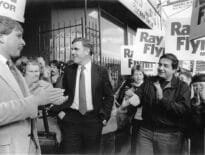Amy Roberts
Executive Vice President and Chief Human Resources Officer, PeoplesBank
Age: 47
Industry experience: 4 years
With some big bank CEOs and other business leaders continuing to push for restricting or ending work-from-home options for staff, Holyoke-based PeoplesBank has taken a different view. The $3.5 billion-asset PeoplesBank has adopted a hybrid working model, giving non-branch employees the flexibility to create schedules that include both in-office and at-home work. For Amy Roberts, the bank’s executive vice president and chief human resources officer, implementing a hybrid schedule has provided a tool to help recruit and retain staff, even as it creates challenges for some managers who need to rethink their approaches to communicating with and supervising staff. Roberts joined PeoplesBank in 2019 with about two decades of human resources experience in several industries, including financial services, insurance and defense.
Q: What approach is PeoplesBank taking toward remote work?
A: When the pandemic first hit, we were not really a remote workplace at all. In a very short period of time, we were able to pivot and put in place a lot of things that allowed most of our administrative office team to work out of their homes. In 2021, we decided that we were going to really commit to flexible work arrangements. Our associates liked it. We felt that we maintained levels of production and effectiveness. Associates work directly with their manager and their business units to determine if they could work hybrid, work fully remote, what works best for the business that they’re a part of, and how to adjust their schedules based on their own needs or desires. Since we implemented that in 2022, most of our office staff have the capability of working hybrid. I typically see people in the office three days a week and working from home two days. We do have a couple of people who are fully remote because their job is able to be completed from their home. But that tends to be less of the norm for us.
Q: What have been staff members’ reactions?
A: They love it. I think people really appreciate the flexibility and the chance to structure their day as it makes the most sense for their workload, what they might have going on in their personal lives in terms of outside work commitments, or just being home earlier than they might have been home if they had to commute. That flexibility factor certainly helps us keep some people in a crazy hiring market, and I think it’s definitely pointed some people in our direction who were looking for a little more flexibility that maybe they didn’t have in the organization they were part of previously.
Q: Have you seen any generational differences in how people react to the hybrid schedule?
A: I don’t know if I’d say generational, but there’s definitely people who feel more productive when they come in the office. And I think there’s people who feel more productive when they’re home. We try to balance that desire to just do one or the other. As a business, we don’t think that full remote would ever be something that would work for our organization culturally. We have a lot of collaborative workspace and teams that need to work across different areas and departments, and so face-to-face time and meeting in-person is still really important to us.
Some managers are really struggling to measure true productivity when they have relied upon their history and their background as, “If I can see you in the office, and I know that you’re here, then I know you’re being productive.” If they don’t have that measure for themselves, they feel at a loss. So, we’ve really shifted a focus from measuring activities to measuring outcomes and really trying to help managers craft objectives and goals for their teams that relate to the outcomes of people’s work. That’s been a transition for us.
Q: How have managers responded to the transition?
A: Some of them have pivoted and just taken it in stride. Others have struggled a little bit more and are looking for some guidance on what to do and what kinds of things should they be putting in place. Because it’s more about the quality of the communication that you’re having with your direct reports. Are you meeting with them regularly? It has to be a little more deliberate if they’re not in the office. Really giving managers some of those tools or different ways of thinking about how they manage has helped, and they’ve been receptive to looking at things a little different. But with anything, it’s change. And change isn’t always easy.
Q: How are you helping branch staff balance their needs?
A: What we have tried to do is think about the staffing, look at banking center hours, and really take a look at how can we make sure that people aren’t working more than five days a week, giving them some time off when they need it, working with each individual schedule-wise. If somebody has a standing outside meeting or obligation, we can accommodate them. I think there’s much more of an openness to trying to work with staff and make sure that they feel like we can work with their needs and balance that schedule they have as well.
Q: What else have you been seeing with this adjustment hybrid scheduling?
A: We’re still, as a society, struggling with this workforce accommodation of hybrid or flexible work. You see on the news a lot of companies are calling people back and canceling hybrid work and saying, “We’re all in the office.” I’m not necessarily sure that that’s the best way to go. I feel like we need to really evaluate how we work and look at it from a standpoint that we’ve got a whole generation of people – our early-career workforce – that don’t view work as the only part of their life. We have to really think smartly about what the way forward is. It feels a little bit like we don’t know how to solve for that, so we’re just going to pull back and go to the old way because that’s what we do. I’m not sure that that’s the best option for us.
Roberts’ Five Favorite Places to Visit:
- Eastham
- Boston
- Key West, Florida
- Bologna, Italy
- Sausalito, California




 |
| 


